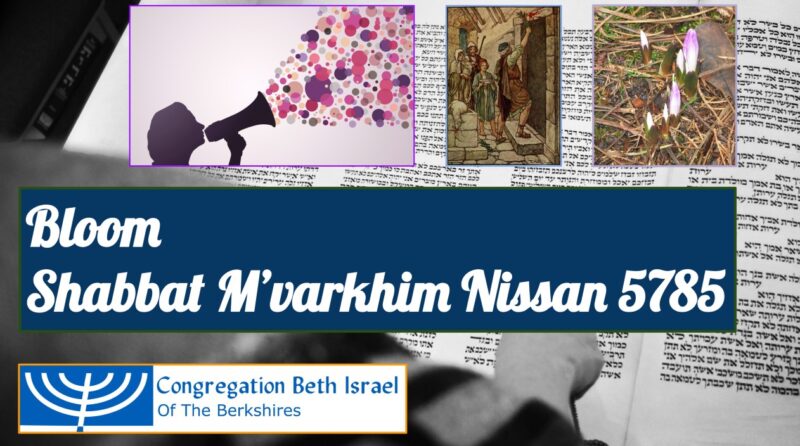הַחֹ֧דֶשׁ הַזֶּ֛ה לָכֶ֖ם רֹ֣אשׁ חֳדָשִׁ֑ים רִאשׁ֥וֹן הוּא֙ לָכֶ֔ם לְחדְשֵׁ֖י הַשָּׁנָֽה׃
This month shall mark for you the beginning of the months; it shall be the first of the months of the year for you. (Ex. 12:2)
 This is the beginning of the special Torah reading assigned to this Shabbat. The new month of Nissan begins on Sunday at sundown – that’s the month containing Passover, and it’s the first month of the year. Some of us might be thinking: Rosh Hashanah is in the fall, so how is the first month of the year now?! The short version is, we have more than one new year. Actually we have four. The year begins again in the fall; the months begin again in the spring.
This is the beginning of the special Torah reading assigned to this Shabbat. The new month of Nissan begins on Sunday at sundown – that’s the month containing Passover, and it’s the first month of the year. Some of us might be thinking: Rosh Hashanah is in the fall, so how is the first month of the year now?! The short version is, we have more than one new year. Actually we have four. The year begins again in the fall; the months begin again in the spring.
Here in the northern hemisphere, spring is a time for new beginnings. And new beginnings aren’t necessarily easy. I think of Louise Glück’s poem The Wild Iris, the way she depicts the new life of a bulb that has pushed its way out of the soil: “the stiff earth / bending a little,” “I tell you I could speak again.” Every bulb that winters over experiences a kind of Exodus from constriction. What a powerful metaphor for us as we prepare ourselves to go free.
Take a lamb, says Torah, and paint its blood on the doorposts. Ibn Ezra (d. 1167) says that was a one time thing, just for the generation of the Exodus. What’s not one time is the instruction to feast with bitter herbs and unleavened bread: hurriedly, with staff in hand and sandals on our feet. This is “a Pesach offering to YHVH,” a “festival to YHVH throughout the ages” (Ex. 12:12,14) – the origins of the ritual feast of retelling we know as the Passover seder.
Intriguingly, Rashi (d. 1105) teaches that the lamb’s blood was meant to be painted on the inside of the doorposts. Abarbanel (d. 1508) agrees: the blood on the doorposts was placed on the inside. Its purpose wasn’t to show something to others, but to remind us of something. Maybe that it’s part of our identity to eat our feast of liberation with sandals on our feet, ready to go. Pesach wasn’t “just” about “them / then” – it is also always about us, here and now.
As we read in the haggadah: בְּכָל-דּוֹר וָדוֹר חַיָּב אָדָם לִרְאוֹת אֶת-עַצְמוֹ כְּאִלּוּ הוּא יָצָא מִמִּצְרַיִם / “in every generation one must see oneself as if one had personally gone forth from Mitzrayim.” So what does it mean to see ourselves into this story? One answer is to map it to our personal narratives of breaking forth from stuck places or oppression. Another is to take responsibility for helping others find their way out of painful and unjust circumstance. I think we need both.
Rabbi Toba Spitzer points out that marking our doors is our first collective act toward liberation:
This is the challenge that our ancestors leave for us. We may no longer be slaves, but the world is still far from redeemed, and these questions still echo for us: What are the steps that we need to take on our own journey of liberation? How do we mark ourselves as both oppressed and free? What is the risk that we each are willing to take, to signal the beginning of new possibilities?
The world is still far from redeemed: that is always true, and this year I know many of us are feeling it especially keenly. Repairing what’s broken in our world is communal work. Just as the building of the Mishkan (the portable dwelling-place for God that our ancestors built in the wilderness) was collective work. And the Exodus from Mitzrayim, the Narrow Place, is always a collective journey. It’s never just about personal transformation; it’s also about community.
Judaism is a communitarian tradition. The highest ideals of Judaism inhere not in any individual practice, but in what we do together: what we do with and for each other, and with and for those who are more vulnerable than we. We “do Jewish” best when we do Jewish together. And that includes seder. As a generous reading of the parable of the four children (and the potential wisdom we can find in each) reminds us, the seder table is big enough to hold our differences.
 Anaïs Nin writes, “The day came when the risk to remain tight in a bud was more painful than the risk it took to blossom.” Every year, Pesach and the unfolding spring invite us to embrace the risk that comes with opening. We open our hearts (internal) which then impels us to take action (external) – to love the stranger, to invite all who are hungry to come and eat, to pursue liberation for all who are bound. The internal is necessary, but not sufficient.
Anaïs Nin writes, “The day came when the risk to remain tight in a bud was more painful than the risk it took to blossom.” Every year, Pesach and the unfolding spring invite us to embrace the risk that comes with opening. We open our hearts (internal) which then impels us to take action (external) – to love the stranger, to invite all who are hungry to come and eat, to pursue liberation for all who are bound. The internal is necessary, but not sufficient.
Were our people ever slaves to a Pharaoh in Egypt? The historical record suggests probably not. But for me that’s beside the point. What matters is that this is the story we’ve been telling about ourselves for well over two thousand years. As Torah reminds us over and over, we know the heart of the stranger because we were strangers in Mitzrayim. And because we know the heart of the stranger, we have an ethical obligation to love the stranger and to help them.
Louise Glück writes, “whatever / returns from oblivion returns / to find a voice.” This year, that speaks to me as a deep truth about recovering from depression, or grief, or any kind of tough time that might feel deadening. I know many of us have felt that, of late. The wild iris’ voice is expressed in its glorious riot of colors. It’s up to us how we express our voice, individual and collective. I believe deeply that the world needs us to use our voice to speak for what’s right.
Earlier this week, masked ICE agents in our own state detained a Turkish graduate student named Rumeysa Ozturk and whisked her off to Louisiana against judicial orders. She was arrested for engaging in “activities in support of Hamas.” As many outlets have reported (from the Guardian to Vanity Fair), the apparent “evidence” of this is that she co-authored an op-ed last year that called on the university to divest from companies with ties to Israel.
As a Jewish community, we will have all kinds of views on that op-ed. Some of us are appalled by it. Some of us agree with it. Both of those are legitimate Jewish opinions, and I hope we can explore them together with curiosity and kindness, maybe around the seder table! I read the op-ed, twice, and it is lightyears away from “supporting Hamas.” And the proposition that someone can be imprisoned for writing an op-ed is profoundly chilling.
Pirkei Avot teaches that we must give others the benefit of the doubt. I believe Jewish values ask us to do this for Rumeysa Ozturk, which means at minimum insisting on due process and compassion for her – and for everyone. My question is: are there places where our reluctance to give the benefit of the doubt becomes a kind of hametz, the pride and puffery of stale stories or unhelpful ego, which we would do well to discard before Pesach?
I spoke recently with one of you who is struggling to figure out how to approach Passover this year given everything unfolding around us. Pesach is about freedom, they noted, but this year many of us don’t feel particularly free… or safe. I told them I draw strength from knowing we aren’t the first generation of Jews to celebrate Pesach in a time of constriction or fear. All we can do is turn to our texts and traditions, and remember that we’re not alone.
The mitzvah most-often repeated in Torah is to love the stranger, precisely because we know what it’s like to be one. This is a deep spiritual truth. Because we’ve known tight places, we have an ethical obligation to free the bound. So as Nissan begins, let’s be like our ancestors. Let’s write a note on the inside of our doorposts about who we intend to be. Let’s take the risk of blooming – and may our flowering lead to the fruits of compassion and justice for all.
This is the d’varling that Rabbi Rachel offered at Kabbalat Shabbat services.





